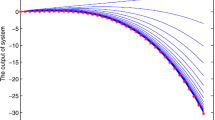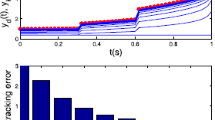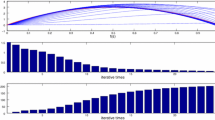Abstract
In this paper, we study the convergence of iterative learning control for some fractional equation. Firstly, by using the Laplace transform and the M-L function, we show the concept of mild solutions. Secondly, by using the Gronwall inequality, we show the sufficient conditions of convergence for the open P-type and the close P-type iterative learning control. At last, we give some examples to illustrate our main results.
Similar content being viewed by others
1 Introduction
In this paper, we will study the convergence of iterative learning control of the following fractional system:
where \({}^{c}\mathrm{D}^{\alpha}_{t}\) denotes the Caputo fractional derivative of order α, \(0<\alpha<1\). \(A\in R^{n\times n}\), the functions f, g are continuous and \(u(t)\) is a control vector.
Iterative learning control (ILC) was described by Uchiyama in 1978 in Japanese, but only few people noticed it. Arimoto et al. developed the ILC idea and studied the effective algorithm until 1984, they made it to be the iterative learning control theory, and more and more people paid attention to it.
Fractional calculus and fractional difference equations have attracted lots of authors in the past years [1–22], because they have been proved to be valuable tools in the modeling of many phenomena in engineering, physics, science, controllability, and they also provide an excellent tool to describe the hereditary properties of various materials and processes. The work on fractional order systems in iterative learning control appeared in 2001, and extensive attention has been paid to this field and great progress has been made in the following 15 years [14, 15, 23–32]; many fractional nonlinear systems were researched [33–37] and some operators have been studied [38, 39]. In [40], the author discussed the controllability of fractional control systems with control delay, and only used the Mittag-Leffler function to deduce the solution. Because it is exponentially bounded, we think that it should to be extensive studied and applied.
Motivated by the above mentioned works, we pay attention to and consider the system (1), the rest of this paper is organized as follows. In Section 2, we will show some definitions and preliminaries which will be used in the following parts. In Section 3, we give some results for P-type ILC for some fractional system. In Section 4, some simulation examples are given to illustrate our main results. In this paper, the norm for the n-dimensional vector \(x=(x_{1},x_{2},\ldots,x_{n})^{T}\) is defined as \(\Vert x \Vert =\max_{1 \leq i \leq n } \vert x_{i} \vert \).
2 Preliminaries
In this section, we will give some definitions and preliminaries which will be used in the paper.
Definition 2.1
The integral
is called a Riemann-Liouville fractional integral of order α, where Γ is the gamma function.
For a function \(f(t)\) given in the interval \([0,\infty)\), we have the expression
where \(n=[\alpha]+1\), \([\alpha]\) denotes the integer part of number α, is called the Riemann-Liouville fractional derivative of order \(\alpha>0\).
Definition 2.2
Caputo’s derivative for a function \(f:[0,\infty)\rightarrow R \) can be written as
where \([\alpha]\) denotes the integer part of real number α.
Definition 2.3
The definition of the two-parameter function of the Mittag-Leffler type is described by
if \(\beta=1\), we get the Mittag-Leffler function of one parameter,
Now, according to [36, 37, 40–42], we shall give Lemma 2.4.
Lemma 2.4
The general solution of equation (1) is given by
where
Lemma 2.5
Lemma 2.4 in [43]
The operators \(S_{\alpha,1}(t)\) and \(S_{\alpha,\alpha}(t)\) are exponentially bounded, we have the constants \(C_{1}=\frac{1}{\alpha }\), \(C_{2}=\frac{1}{\alpha} \Vert A \Vert ^{\frac{1-\alpha}{\alpha}}\),
Lemma 2.6
[34] Generalized Gronwall inequality
Let \(u(t)\) be a continuous function on \(t\in [0,T]\) and let \(v(t-s)\) be continuous and nonnegative on the interval \(0\leq s \leq T\). Moreover, let \(W(t)\) be a positive continuous and non-decreasing function on \(t \in[0,T]\). If
then
3 P-type ILC for some fractional system
In this section, we consider the following fractional equation:
\(x^{k}\) denotes the kth iteration of x, \(u^{k}\) denotes the kth iteration of u, k is the number of iterations, \(k\in\{0,1,2,\ldots \} \).
Firstly, we will make the following assumptions on the data of our problem.
- H(1):
-
The function \(f:R^{n}\times R^{n}\times J\rightarrow R^{n}\) satisfies:
-
(i)
f is measurable for all \(t\in J\);
-
(ii)
for \(1\leq i\leq n\), there exists a constant \(L_{f}>0\) such that
$$\bigl\vert f\bigl(x_{i}^{k}(t),u_{i}^{k}(t),t \bigr)-f\bigl(\overline{x}_{i}^{k}(t),\overline {u}_{i}^{k}(t),t\bigr) \bigr\vert \leq L_{f} \bigl( \bigl\vert x_{i}^{k}(t)-\overline {x}_{i}^{k}(t) \bigr\vert + \bigl\vert u_{i}^{k}(t)-\overline {u}_{i}^{k}(t) \bigr\vert \bigr) $$for all \(x_{i}^{k},u_{i}^{k},\overline{x}_{i}^{k},\overline{u}_{i}^{k}\in R\).
-
(i)
- H(2):
-
\(g:R^{n}\times R^{n}\times J\rightarrow R^{n}\), for \(\beta _{j}>0\), \(j=1,2,3,4\),
$$\textstyle\begin{cases} \beta_{1}\leq g_{iu}^{k}:=\frac{\partial g(x_{i}^{k}(t),u_{i}^{k}(t),t)}{\partial u_{i}^{k}(t)} \leq\beta_{2},\\ \beta_{3}\leq g_{ix}^{k}:=\frac{\partial g(x_{i}^{k}(t),u_{i}^{k}(t),t)}{\partial x_{i}^{k}(t)} \leq\beta_{4}, \end{cases} $$we also denote \(\triangle x_{i}^{k}(t):=x_{i}^{k+1}(t)-x_{i}^{k}(t)\), \(\triangle u_{i}^{k}(t):=u_{i}^{k+1}(t)-u_{i}^{k}(t)\); \(e_{i}^{k}(t):=y_{i}^{d}(t)-y_{i}^{k}(t)\) is the tracking error function, \(y^{d}(t)=(y_{1}^{d},y_{2}^{d},\ldots,y_{n}^{d})^{T}\) is the objective function.
3.1 Open-loop case
For equation (4), we consider the following Open-loop P-type ILC, \(t\in [0,b]\), \(1\leq i\leq n\):
where γ and \(\delta_{1}\) are the parameters which will be determined.
Theorem 3.1
Assume that the hypotheses H(1), H(2) are satisfied, let \(y_{k}(\cdot)\) be the output of equation (4), for the arbitrary input \(u_{0}(\cdot)\), if
the open-loop P-type ILC (5) guarantees that \(\lim_{k\to\infty} y_{i}^{k}(t)=y_{i}^{d}(t)\), or \(\lim_{k\to\infty} \Vert e^{k}(t) \Vert =0\), \(t\in J\).
Proof
Firstly, we know that \(e_{i}^{k}(t):=y_{i}^{d}(t)-y_{i}^{k}(t)\), by using the mean value theorem, we get
where \(\xi_{1}(t)\) lies in the segment with the end point \(x _{i}^{k}(t)\) and \(x _{i}^{k+1}(t)\), \(\xi_{2}(t)\) lies in the segment with the end point \(u _{i}^{k}(t)\) and \(u _{i}^{k+1}(t)\).
(I) \(t=0\). By using (5) and (6), we get
so
(II) \(t\in(0,b)\). According to assumptions H(1), H(2) and (3), we can show that
let \(W(t)=C_{1} e^{ \Vert A \Vert ^{\frac{1}{\alpha}}t} \vert \triangle x_{i}^{k}(0) \vert +b L_{f}C_{2}e^{ \Vert A \Vert ^{\frac{1}{\alpha}}b} \Vert \triangle u^{k} \Vert \), invoking Lemma 2.5 and Lemma 2.6, we get
In light of (9),
where
the proof is completed. □
3.2 Closed-loop case
For equation (4), we consider the closed-loop P-type ILC, \(t\in[0,b]\):
we set
Theorem 3.2
Assume that the hypotheses H(1), H(2) are satisfied, let \(y_{k}(\cdot )\) be the output of the system (4), \(y_{d}(t)\) be the given function, for the arbitrary input \(u_{0}(\cdot)\), if
the closed-loop P-type ILC (10) guarantees that \(\lim_{k\to\infty} y_{i}^{k}(t)=y_{i}^{d}(t)\), or \(\lim_{k\to\infty} \Vert e^{k}(t) \Vert =0\), \(t\in J\).
Proof
According to H(1), H(2) and (10),
It can easily be seen from (3), \(\lim_{k\to\infty} \Vert e^{k}(0) \Vert _{L^{2}}=0\).
For \(t\in(0,b]\), we obtain
Therefore
it implies that \(\lim_{k\to\infty} \Vert e^{k} \Vert =0\), \(t\in J\), which completes the proof. □
4 Simulations
In this section, we will give two simulation examples to demonstrate the validity of the algorithm.
4.1. Consider the following Open-loop P-type ILC system:
with the iterative learning control
we set \(f=(x_{1}^{k}(t))^{2}\) and the initial control \(u_{0}(\cdot)=0\), \(y_{1}^{d}(t)=5t^{2}(3-2t)\), \(t\in[0,1.8]\), and set \(L_{f}=0.01\), \(\beta _{1}=0.2\), \(\beta_{2}=0.7\), \(\beta_{3}=0.5\), \(\beta_{4}=0.1\), \(\gamma=0.5\), \(\delta_{1}=0.5\), all conditions of Theorem 3.1 are satisfied.
The simulation result can be seen from Figure 1 and Figure 2, for the Open-loop P-type ILC system (15), with the increase of the number of iterations, it can track the desired trajectory gradually by using the algorithm. Firstly, we use the single iteration rate to get the result, from Figure 1, we find that late in the iteration, the output of the system jumps around the desired trajectory, so we adopt the correction method, that is, when \(e^{j}>0\), \(u^{j}=u^{j}-0.5\times e^{j}\) or \(e^{j}<0\), \(u^{j}=u^{j}+0.5\times e^{j} \), j is the number of iteration, the result approaches the desired trajectory stably and quickly; from Figure 2, the tracking error tends to zero at the 14th iteration, so the iterative learning control is feasible and the efficiency is higher.
4.2. Consider the following Closed-loop P-type ILC system:
with the iterative learning control
we set the initial control \(u_{0}(\cdot)=0\), \(y_{1}^{d}(t)=12t^{2}\), \(t\in [0,1.8]\), and \(L_{f}=0.015\), \(\beta_{1}=0.25\), \(\beta_{2}=0.6\), \(\beta_{3}=0.5\), \(\beta _{4}=0.1\), \(\gamma=0.5\), \(\delta_{2}=1\), all conditions of Theorem 3.2 are satisfied. We also use the correction method, that is, when \(e^{j}>0\), \(u^{j}=u^{j}-m\times e^{j}\) or \(e^{j}<0\), \(u^{j}=u^{j}+m\times e^{j} \), j is the number of iteration, m is the parameters, we set \(m=0.7,1,1.2\) and the output of the system is shown in Figure 3, Figure 5 and Figure 7, the tracking error is shown in Figure 4, Figure 6 and Figure 8.
From Figure 3-Figure 8 and Table 1, we find the tracking error tends to zero within six iterations, so the output of the system can track the desired trajectory almost perfectly. By comparing three cases, when \(m=1\), the iteration number is only 2, and the tracking error is 0.001, the tracking performance is best and improved over the iteration domain.
5 Conclusions
In this paper, the convergence of iterative learning control for some fractional equation was discussed. Based on our results, the Open-loop and Closed-loop P-type ILC law were proposed, by using the Gronwall inequality, the sufficient conditions of convergence for the two types of iterative learning control were showed. Simulation results showed that the algorithm is effective. In the future, we will study iterative learning control for some fractional equation with impulse or delay.
References
Miller, KS, Ross, B: An Introduction to the Fractional Calculus and Differential Equations. Wiley, New York (1993)
Kilbas, AA, Srivastava, HM, Trujillo, JJ: Theory and Applications of Fractional Differential Equations. North-Holland Mathematics Studies, vol. 204. Elsevier, Amsterdam (2006)
Lakshmikantham, V, Leela, S, Vasundhara Devi, J: Theory of Fractional Dynamic Systems. Cambridge Academic Publishers, Cambridge (2009)
Diethelm, K: The Analysis of Fractional Differential Equations. Springer, Berlin (2010)
Wang, J, Zhou, Y, Medved, M: On the solvability and optimal controls of fractional integrodifferential evolution systems with infinite delay. J. Optim. Theory Appl. 152, 31-50 (2012)
Wang, J, Zhou, Y: A class of fractional evolution equations and optimal controls. Nonlinear Anal., Real World Appl. 12, 262-272 (2011)
Wang, J, Zhou, Y: Analysis of nonlinear fractional control systems in Banach spaces. Nonlinear Anal. 74, 5929-5942 (2011)
Wang, J, Zhou, Y: Existence and controllability results for fractional semilinear differential inclusions. Nonlinear Anal., Real World Appl. 12, 3642-3653 (2011)
Wang, J, Zhou, Y, Feckan, M: On recent developments in the theory of boundary value problems for impulsive fractional differential equations. Comput. Math. Appl. 64, 3008-3020 (2012)
Wang, J, Feckan, M, Zhou, Y: Ulam’s type stability of impulsive ordinary differential equations. J. Math. Anal. Appl. 395, 258-264 (2012)
Wang, J, Feckan, M, Zhou, Y: On the new concept of solutions and existence results for impulsive fractional evolution equations. Dyn. Partial Differ. Equ. 8, 345-362 (2011)
Wang, J, Zhou, Y, Feckan, M: Nonlinear impulsive problems for fractional differential equations and Ulam stability. Comput. Math. Appl. 64, 3389-3405 (2012)
Wang, J, Zhou, Y, Wei, W, Xu, H: Nonlocal problems for fractional integrodifferential equations via fractional operators and optimal controls. Comput. Math. Appl. 62, 1427-1441 (2011)
Wang, J, Zhang, Y: On the concept and existence of solutions for fractional impulsive systems with Hadamard derivatives. Appl. Math. Lett. 39, 85-90 (2015)
Wang, J, Ibrahim, AG, Feckan, M: Nonlocal impulsive fractional differential inclusions with fractional sectorial operators on Banach spaces. Appl. Math. Comput. 257, 103-118 (2015)
Zhang, L, Ahmad, B, Wang, G: Explicit iterations and extremal solutions for fractional differential equations with nonlinear integral boundary conditions. Appl. Math. Comput. 268, 388-392 (2015)
Zhang, X: On the concept of general solution for impulsive differential equations of fractional-order \(q \in(1, 2)\). Appl. Math. Comput. 268, 103-120 (2015)
Ge, F, Zhou, H, Ko, C: Approximate controllability of semilinear evolution equations of fractional order with nonlocal and impulsive conditions via an approximating technique. Appl. Math. Comput. 275, 107-120 (2016)
Arthi, G, Park, JH, Jung, HY: Existence and exponential stability for neutral stochastic integrodifferential equations with impulses driven by a fractional Brownian motion. Commun. Nonlinear Sci. Numer. Simul. 32, 145-157 (2016)
Hernández, E, O’Regan, D, Balachandran, K: On recent developments in the theory of abstract differential equations with fractional derivatives. Nonlinear Anal. 73(10), 3462-3471 (2010)
Zayed, EME, Amer, YA, Shohib, RMA: The fractional complex transformation for nonlinear fractional partial differential equations in the mathematical physics. J. Assoc. Arab Univ. Basic Appl. Sci. 19, 59-69 (2016)
Zhang, X, Zhang, B, Repovš, D: Existence and symmetry of solutions for critical fractional Schrödinger equations with bounded potentials. Nonlinear Anal., Real World Appl. 142, 48-68 (2016)
Bien, Z, Xu, JX: Iterative Learning Control Analysis: Design, Integration and Applications. Springer, Berlin (1998)
Chen, YQ, Wen, C: Iterative Learning Control: Convergence, Robustness and Applications. Springer, Berlin (1999)
Norrlof, M: Iterative learning control: analysis, design, and experiments. Linkoping Studies in Science and Technology, Dissertations, No. 653, Sweden (2000)
Xu, JX, Tan, Y: Linear and Nonlinear Iterative Learning Control. Spring, Berlin (2003)
Wang, Y, Gao, F, Doyle, FJ III: Survey on iterative learning control, repetitive control, and run-to-run control. J. Process Control 19(10), 1589-1600 (2009)
de Wijdeven, JV, Donkers, T, Bosgra, O: Iterative learning control for uncertain systems: robust monotonic convergence analysis. Automatica 45(10), 2383-2391 (2009)
Wang, J, Feckan, M, Zhou, Y: A survey on impulsive fractional differential equations. Fract. Calc. Appl. Anal. 19, 806-831 (2016)
Liu, S, Debbouche, A, Wang, J: On the iterative learning control for stochastic impulsive differential equations with randomly varying trial lengths. J. Comput. Appl. Math. 312, 47-57 (2017)
Yu, X, Debbouche, A, Wang, J: On the iterative learning control of fractional impulsive evolution equations in Banach spaces. Math. Methods Appl. Sci. (2015). doi:10.1002/mma.3726
Xu, JX: A survey on iterative learning control for nonlinear systems. Int. J. Control 84(3), 1275-1294 (2011)
Li, Y, Chen, Y, Ahn, H: Fractional-order iterative learning control for fractional-order systems. Asian J. Control 13(1), 1-10 (2011)
Lan, Y: Iterative learning control with initial state learning for fractional order nonlinear systems. Comput. Math. Appl. 64(10), 3210-3216 (2012)
Lin, M, Yen, C, Tsai, M, Yau, H: Application of robust iterative learning algorithm in motion control system. Mechatronics 23(5), 530-540 (2013)
Li, Y, Jiang, W: Fractional order nonlinear systems with delay in iterative learning control. Appl. Math. Comput. 257(15), 546-552 (2015)
Wang, J, Feckan, M, Zhou, Y: Center stable manifold for planar fractional damped equations. Appl. Comput. Math. 296, 257-269 (2017)
Zhou, Y, Jiao, F: Existence of mild solutions for fractional neutral evolution equations. Comput. Math. Appl. 59(3), 1063-1077 (2010)
Mophou, GM, N’Guérékata, GM: Existence of mild solutions of some semilinear neutral fractional functional evolution equations with infinite delay. Appl. Math. Comput. 216, 61-69 (2010)
Wei, J: The controllability of fractional control systems with control delay. Comput. Math. Appl. 64(10), 3153-3159 (2012)
Liu, S, Wang, J, Wei, W: Iterative learning control based on a noninstantaneous impulsive fractional-order system. J. Vib. Control 22, 1972-1979 (2016)
Li, M, Wang, J: Finite time stability of fractional delay differential equations. Appl. Math. Lett. 64, 170-176 (2017)
Bazhlekova, E: Fractional evolution equations in Banach spaces. Ph.D Thesis, Eindhoven University of Technology (2001)
Acknowledgements
Project supported by the National Natural Science Foundation of China (Grants nos. 71461027, 71471158), Zunyi Normal College Doctoral Scientific Research Fund BS[2014]19, BS[2015]09, Guizhou Province Mutual Fund LH[2015]7002, LH[2015]7006, LH[2016]7028, Guizhou Province Department of Education Fund (qian jiao he) KY[2014]295, KY[2015]391, KY[2015]451, KY[2016]046, Guizhou Province Department of Education teaching reform project [2015]337, Guizhou Province Science and technology fund (qian ke he ji chu) [2016]1160, [2016]1161, (qian ke he j zi) [2015]2147, Zunyi Science and technology talents [2016]15, Innovative talent team in Guizhou Province (Qian Ke HE Pingtai Rencai) [2016]5619.
The authors thank the referees for their careful reading of the manuscript and insightful comments, which helped to improve the quality of the paper. We would also like to acknowledge the valuable comments and suggestions from the editors, which vastly contributed to improving the presentation of the paper.
Author information
Authors and Affiliations
Corresponding author
Additional information
Competing interests
The authors declare that they have no competing interests.
Authors’ contributions
All authors contributed equally to the writing of this paper. All authors read and approved the final manuscript.
Publisher’s Note
Springer Nature remains neutral with regard to jurisdictional claims in published maps and institutional affiliations.
Rights and permissions
Open Access This article is distributed under the terms of the Creative Commons Attribution 4.0 International License (http://creativecommons.org/licenses/by/4.0/), which permits unrestricted use, distribution, and reproduction in any medium, provided you give appropriate credit to the original author(s) and the source, provide a link to the Creative Commons license, and indicate if changes were made.
About this article
Cite this article
Liu, X., Li, Y. & Liu, Y. The convergence of iterative learning control for some fractional system. Adv Differ Equ 2017, 132 (2017). https://doi.org/10.1186/s13662-017-1177-3
Received:
Accepted:
Published:
DOI: https://doi.org/10.1186/s13662-017-1177-3












